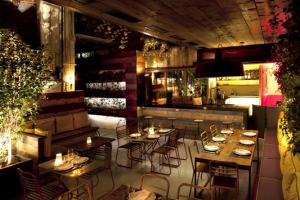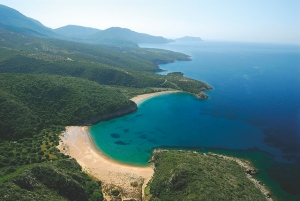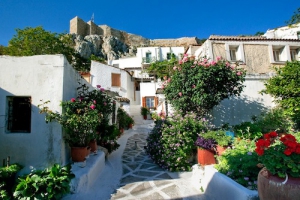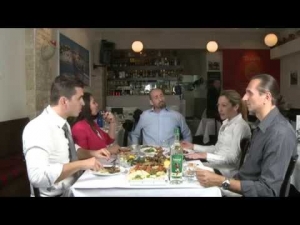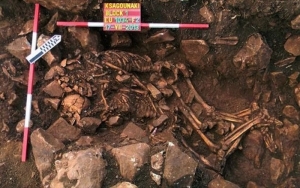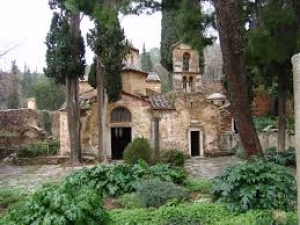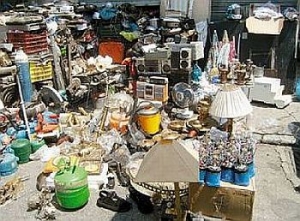LIFE & CULTURE
XpatAthens
A Taste Of Athens - Off The Beaten Path Restaurants
For many visitors Athens is defined by its old city quarters, flea markets, spice markets, ancient wonders and fabulous museums. Sounds like a pretty great menu… Almost spoilt for choice, but once the Plaka has been checked off the list then what? Well, I have discovered something about Athens too…..the ‘undiscovered’ side of her and by that I mean the local way of life that is not openly shared with tourists and visitors alike. While this city promotes her cultural delights and unique heritage I ponder on why they don’t do the same for her culinary delights, electric nightlife and superb coast line.
Not to say it’s a totally closed notion that people aren’t aware of the beaches and restaurants but it’s not a city known for its ‘modern flavours’. So let’s open that book and take people through it chapter by chapter. Chapter 1: Off the Beaten Path.
Here's the Athens restaurant scene, but maybe not as you know it! These places will certainly leave your tastebuds pleasantly surprised!
Kifissia
A pretty, leafy suburb located in North Athens offers more than just a stroll down it’s charming streets. Don’t forget to take the horse and carriage ride…..
- Tzitzikas Kai O Mermingas – Modern Greek cuisine that will tantalize your taste buds and leave you obsessed with the ‘honey & cheese’ food combination.
- Il Salumaio d'Atene – One of my favorites in Athens! Beautiful outdoor seating area with sublime dishes ranging from eggs benedict to homemade pizza!
- Πbox [pronounced P-BOX] – Pan Asian concoction of modern delights. Πbox is also located in the Periscope Hotel in Kolonaki.
- The Dalliance House – Neo-Classic style house with an elegant English pub feel serving delicious meat, seafood and salads.
- New Dash – For those who want to eat something yummy but are also prepared for the prices to eat their wallet.
Nea Erythraia
Cool, hip and trendy neighbourhood mostly known for its ‘Little Mykonos’ night vibe. Just behind the high street is a playground full of bars offering an array of nightly haunts. Low Bar is always a great starting point. Check it out!
- Ergon – Modern and sublime dishes masterfully created bringing you the very best of Greek cuisine with a twist. They also sell homemade produce such as jams, condiments, bon bons and much more. They have a sister restaurant in London, UK.
- Manaviko – Traditional Greek cuisine offering fresh ingredients. Think traditional Greek food but with more flare.
- Bar-Que – American style restaurant with an array of meat and fish dishes. The menu sometimes samples Pan Asian tidbits.
- Χρώματα Βυθού (Chromata Vythou) – Fish and seafood delights…..summer is the best time to visit; surrounded by the warm, tones of the pink bougainvillea’s dotted around the garden.
Psychiko
Hidden little gem of an area dominated by foreign embassies and some true culinary master pieces. A neigbourhood that needs exploring.
- The Albion – Think fairy’s playground lit up with warm lights snuggled with trees. The food is delectable and the outdoor bar a must for the ‘trendy’.
- Fish Co. Platters – Fresh fish with organic ingredients
- Κρίθαμος [Krythamos] – Wonderful taverna serving delicious Greek produce that will leave you wanting more!!
- Xoxladaki [Chochladaki] - Delicious Seafood restaurant with scrumptious apperizers and a fantastic ouzo selection.....time to drink....Greek style!
Hilton District
Conveniently located close to the Hilton Hotel and within close proximity of central Athens.
- Vezene – Local’s favorite - serving wagyu beef and a marvelous view of the Hilton Hotel. Tip: The truffle fries are to die for!
Kolonaki
In the heart of the city is the chic neighbourhood of Kolonaki, not only does Kolonaki boast prime location but also an array of great restaurants and bars. Not a foodie? Perfect! You will be in a shopper’s paradise with boutique shops and high street brands galore! It’s easy to get lost here and why not? You’ll be doing it in style!
- Inbi – The best sushi in town! The ambience is warm and inviting and you will be sure to find the trendy Athenians here. The cocktails are also worth a try!
- Malconi’s– Italian food at its finest serving up fresh produce such as meats, fish and pizzas. Make sure you request a table in their secret garden at the back of the restaurant.
- Scala Vinoteca – Tapas style bar in an attractive modern setting.
- Capanna – Pizza restaurant with colorful toppings and exciting flavours.
Glyfada
Los Angeles’ European replica, Glyfada is a buzzing neighbourhood with endless dining, shopping and entertainment options. From independent boutique shops to a concoction of dining madness. Something for everyone in Glyfada! [Popular with British Expats]
- Mutfak – A taste of Istanbul in Athens! Delicious Turkish cuisine in a cozy modern atmosphere. Well worth the visit to Glyfada.
- Peccati di Gola – Italian dream! This is a must when in Athens!
- Molly’s Irish Pub – fun local pub that serves up some great grub!
- Food Mafia – American style restaurant proving to be very popular with the locals.
Vouliagmeni
Often compared to the South of France this beautiful neighbourhood not only boasts sublime restaurants and luxury hotels but the best beaches in town.
- Ithaki – fancy eating seafood overlooking the Saronic Gulf? Wedged between a mountain and Astir Beach diners get a real treat with both the beautiful view and yummy morsels on your plate both vying for your attention.
- Astir Beach – it might cost 15 EUR to enter but with service at a press of a button and sun lounges one can sink into it’s worth your time and money. Other beaches I suggest: Kavouri Beach, Yabanaki Beach, Varkiza Beach & South Coast. [All located South Athens].
- Lake Vouliagmeni – Remember the natural lake I mentioned? Well prepare to be spellbound as you immerse yourself into the clean and pristine turquoise water of this hidden gem. Garra Rufa [Doctor Fish] will greet your feet as you enter the cool lake offering you a free pedicure and a sense of enlivenment. A must when in Athens!
To read this article in full, please visit: Table Salt
A big thanks to Costas Psarros from Table Salt for sharing this with us!
Do you have a recommendation or recipe to share? Send it to us at ideas@xpatathens.com!
Minimum Salary To Rise To €654 In October
The first part of a government plan to increase the minimum salary is expected to be implemented in October, taking the level up to 654 euros per month for all private sector workers. The government’s election pledge to raise the minimum monthly salary to 751 euros will not be fulfilled before the second half of 2016.
The Labor Ministry is currently planning for two regulations, which will bring the salaries paid to young workers up to the same level as those received by older workers, as well as the minimum salary of menial workers to that of office employees. That way, if Parliament clears both measures, no worker should get less than 654 euros per month.
To read more please visit: ekathimerini.com
By Roula Salourou
10 Best Places To Visit In Greece
Known for its plethora of ancient ruins, whitewashed villages, sunny beaches, tasty cuisine and friendly atmosphere, it is no wonder that Greece ranks among Europe’s top travel destinations. Greece is made up of a mountainous mainland and hundreds of islands where each one offers its own share of stunning landscapes, historic sites, nightlife scenes and cultural delights. Here's an overview of the best places to visit in Greece:
10: Cape Sounion
Situated at the southernmost tip of the Attica peninsula, Cape Sounion is best known as the site of the ruins of the ancient Greek temple of Poseidon, the god of the sea. The remains are perched on the headland, surrounded on three sides by the sea. The site is a popular day-excursion for tourists from Athens, with sunset over the Aegean Sea, as viewed from the ruins, a sought-after spectacle.
9: Thessaloniki
Thessaloniki is Greece’s second-largest city and the capital city of the Macedonian region of Northern Greece. Lively festivals, social events and a buzzing nightlife make this city the cultural capital of Greece. Comprised of a historic city center and commercial district, Thessaloniki offers both old and new attractions from its Byzantine walls, White Tower and Turkish baths to colorful food markets, museums and art galleries.
8: Zagori
Zagori is a region of great natural beauty, with striking geology and two national parks, in northwestern Greece. It’s dense forests and rugged mountains are furrowed by powerful rivers and dotted with traditional villages, many featuring grand stone houses dating from the late eighteenth century. The best way to enjoy the area is by hiking the numerous paths connecting the villages. The most accessible and rewarding target is the wonderful Víkos Gorge.
7: Halkidiki
Halkidiki is a trident-like peninsula near the city of Thessaloniki, sporting excellent beaches. The three separate peninsulas can be roughly summarized as follows: Kassandra has the nightlife, Sithonia has the beaches and Athos has the monks. Being closest to Thessaloniki, Kassandra is more built-up, while the more quiet Sithonia has campgrounds, hidden coves and clear waters. Both are popular with Greek and Eastern European tourists. Much of the easternmost peninsula belongs to the Mount Athos monastic community. It’s accessible by boat and open to male pilgrims only.
6: Peloponnese
Shaped much like a large leaf, Peloponnese was traditionally called Morea, which means mulberry leaf. Located in the southernmost region of both Europe and Greece, Peloponnese is a wide peninsula connected to the mainland by the Rio-Antirrio bridge. Interspersed with classical Greek temples, Venetian fortresses, Byzantine churches and Mycenaean palaces, Peloponnese echoes the ancient cultures and events from its extensive history.
5: Delphi
Second to the Acropolis in Athens, Delphi is Greece’s most popular archaeological site. Located about two and half hours from Athens along the slopes of the awe-inspiring Mount Parnassus, Delphi was once revered by the ancient Greeks as the center of the earth.
4: Meteora
The Greek word meteora means “suspended in the air,” and this phrase aptly describes the spectacular cliffs that rise more than 1,200 feet (366 meters) into the air overlooking the villages of Kalambaka and Kastraki in the north central mainland of Greece. What makes these cliffs even more inspiring are the historic monasteries perched along the summits. Dating back to the 14th and 16th centuries, these monasteries were built by monks seeking spiritual isolation and freedom from religious persecution.
To read more please visit: Touropia
Anafiotika - A Village Within A City
There’s a part of Athens that had always eluded me. I had never been able to find it! Anafiotika is the neighbourhood, located under the northeastern side of the Acropolis Hill, part of historical Plaka.
History
The neighbourhood came into being in the reign of Otto of Greece – the Bavarian prince who in 1832, became the first modern King of Greece. Construction workers were needed to work on the King’s Palace, and they came from the island of Anafi, a tiny island in the Cyclades chain and with a population in 2011 of 271.
Up until 1922, inhabitants of Anafiotika were from Anafi island, then this tiny neighbourhood saw immigrants from Asia Minor start to arrive.
For archeological reasons, in 1950 many of the little houses were destroyed, and in 1970 the Greek state started to buy them.
Modern times
Today there are only 45 houses remaining. However, wandering through the alleyways and seeing this unique neighbourhood – planned so that it resembled a Greek island – really does make you feel like you’ve stepped back in time. Away from the noise and hustle bustle, I loved it there – and am glad I finally found it!
"Up, keep walking up"
I was instructed. Yes, more than once locals would wave their arm in a vague motion that is so typical to the Greeks, in the direction of the Acropolis Hill. This time – my third attempt I might add – I did just that, I found ways to keep walking ‘up.’ Not knowing if I should be walking through certain streets, I stumbled across more street art.
To read more, please visit: LifeBeyondBordersBlog
By Rebecca Hall
How One Philadelphia Entrepreneur Is Helping Greece
Manos Sifakis left Greece to study at one of the most prestigious technical universities in the world— the University of Manchester Institute of Science and Technology in the UK— also known as the MIT of Europe. He left his farming community in Larissa, in central Greece, thinking very well that he’d return to his family, his friends and his way of life after studies to start his own computer business.
Conditions in Greece forced him to change his plans and head to the United States, where he took up residence in Philadelphia and started customedialabs in 2000.
Fast forward fifteen years— the company is a leader in the digital marketing space with major Fortune 500 clients like ING, Bayer Pharmaceuticals, Johnson & Johnson and Exxon Mobil having been serviced out of the company’s offices in suburban Philadelphia and— Sifakis’ hometown of Larissa, 200 miles north of Athens.
In Philadelphia, customedialabs has 12 employees in operations, client services and client management, while his Greece office has 40 employees ranging from the creative team, various software engineers, user experience architects and quality assurance.
For Sifakis, there’s no better way to “support” Greece than by supporting and empowering its human capital.
“We could easily staff our office here in the United States with developers, designers and all the positions we need to do the work for our clients,” Sifakis told The Pappas Post.
“But why not staff these positions with able-bodied, talented people in Greece? This is my way of helping— not with charity, but by employing 40 Greeks and supporting 40 Greek families struggling through this crisis and offering these people employment, professional development and dignity— which they deserve. These people can dream again, and for me, that’s a big thing.”
And work isn’t all Sifakis is offering them. He focuses a lot of offering professional development for the people who work for him in Greece. Many have gotten their start with customedialabs and have moved on to big Silicon Valley and European tech companies. Sifakis gave them the opportunity to interface for the first time with a global audience, essentially building their portfolio and resumes.
To read more please visit: ThePappasPost
New Greek President Sworn In
The newly-sworn in President of the Republic, Prokopis Pavlopoulos, said on Friday that everyone has to contribute to help the country exit the crisis, during a handover ceremony with outgoing President Karolos Papoulias at the Presidential Mansion.
Papoulias received Pavlopoulos with a handshake and went to the outgoing president’s office where they had a brief conversation. "I am certain you will make an excellent President. You served in important ministries, you were an excellent professor. You take over at a difficult time; there are many problems and many issues at stake; mostly the issue of achieving a national consensus,” Papoulias said.
"I am certain you will do everything in your power to create a stable ground for achieving national reconciliation,” he added.
"We all have to contribute to help the country exit from the deep crisis, to fight the two scourges of poverty and unemployment and especially youth unemployment,” Pavlopoulos responded, and spoke of a difficult fight which is shared by all political parties, not just in Greece, but in Europe as well.
Pavlopoulos praised Papoulias tenure, saying it was “an exceptional honour” to succeed him. "You exercised your duties perfectly, especially in the last difficult period … and its extremely important for one to leave the Presidency with this knowledge, with this legacy.”
To read more please visit: TheTOC
Video: The Draconian Decision Of The German Drachma
What would happen if Germany was poor and Greece was rich? How would the Greek Cabinet deal with the request for a 100 Billion Euro request? This short film is set in Athens in 2019 using famous names from the looooong history of Greece (Alcibiades, Mercouri, Leonidas, Venizelos), this satirical film is a must.
It is also the second film in this series, the first will be released in March (yes we are playing the reverse).
By Billy Cotsis
Embracing Neolithic Couple Found In Diros Cave
A rare Neolithic-era find of the skeletons of a couple embracing was found in excavations by the northern entrance of the Alepotrypa (“Foxhole”) Cave in southern Greece, the Archaeological Service announced on Thursday.
The undisturbed burial was found close to a burial of another male and female who were found in fetal position. The burials also contained broken arrowheads.
The embracing couple’s skeletons were dated with the C14 method to 3800 BC while their DNA analysis confirmed the remains were those of a male and female.
Both burials are part of a Neolithic cemetery in the greater area of the Neolithic Diros Cave, in western Mani, where excavations have yielded children’s, embryos’ and adults’ burials dated from 4200 to 3800 BC. According to most recent data and analyses, the cave appears to have been in use from Early to Final Neolithic (6000-3200 BC) and served throughout as settlement and cemetery.
At the end of the Final Neolithic (3200 BC), a severe earthquake sealed the entrance of the cave and the remains of its inhabitants inside. Excavations began after an accidental discovery by speleologists Yiannis and Anna Petrocheilos in 1958.
To read more, please visit greekreporter.com
By A. Makris
The Monastery Of Kaisariani And Koutouki Cave
The murals that adorn the interior of the church date back to the 16th century AD. They have been influenced from the Athonite and Cretan Schools of Art.
The monastery of Kaisariani had a very rich library and became a significant centre of philosophy. Very important philosophers and scholars of the time, including George Gemistos Plethon, taught here.
The monastery of Kaisariani closed in 1832 upon a decision of king Otto’s regency, the same as almost all the monasteries of Mt Hymettus did.
With 44 different types of orchids alone, Mt Hymettus is an oasis often overlooked by people visiting Athens. Covered with pine forests and small lush valleys, this lung of Athens gives a welcome relief from the hustle and bustle of the city. With well-marked paths leading you up to green slopes, every season hides special delights.
A true botanical paradise, Mt Hymettus - also known as Trelos (Crazy) in modern times - has been renowned since antiquity for its honey and the colour of its marble, of a slightly darker hue than that of Penteli. The mountain is long, narrow, rocky and arid, with a flora that numbers over 600 plant species. These include 31 endemic species, whilst the most interesting plants are to be found among the shrubs. This low mountain has one of the richest assortments of orchids in Greece and Europe (44 species). When walking through the brush above the Monastery of Kaesariani, you can easily come across over ten orchid species in less than an hour.
Mt Hymettus provides refuge to endangered bird species, including the rare Sardinian warbler, the rock nuthatch, the peregrine falcon, the osprey and the long-legged buzzard. Island grouse are rife on the mountain and can easily be recognised by their clucking.
There are sites of cultural importance in the area, such as the Monastery of Kaesariani and the protected Kaesariani Aesthetic Forest. Mt Hymettus has dozens of caves and coves, but the Paeania cave is the most impressive sight. An interesting geological phenomenon is Lake Vouliagmeni, where the southern protrusion of the mountain skirts upon the Saronic Gulf. The lake was once a large sea cave whose roof collapsed and has, today, become a holiday and recreation resort. The entire mountain, from the Paeania cave in the north to Lake Vouliagmeni in the south, is protected by the NATURA 2000 European network.
In the summer the scent of thyme and oregano wafts with each step you take on the dried undergrowth, while in spring the blooming wild flowers decorate the mountain sides with their colours. Surprisingly, the 600 plant species make Mt Hymettus, in proportion to its size, one of the richest environments in entire Europe, as far as flora is concerned. There are also many sites of historical interest hidden on the mountain, including the remains of old churches, (ex. Saint Mark), and the monastery of Kaesariani nestled in one of the forested valleys. From the top you can enjoy the view of Athens, the Saronic Gulf and the mountains of the Peloponnese.
 Koutouki Cave is located on the eastern slope of Mount Ymittos, outside the town of Peania. It was discovered by accident several years ago, when a goat fell into the cave through a hole in its roof. The shepherd climbed in to rescue the animal and discovered one of Europe's most beautiful caves. Nowadays, visitors can enter the cave through a tunnel to admire the impressive stalagmites and stalactites. A guided tour of the cave starts every 30 minutes. It can be reached from the city centre by car in an hour.
Koutouki Cave is located on the eastern slope of Mount Ymittos, outside the town of Peania. It was discovered by accident several years ago, when a goat fell into the cave through a hole in its roof. The shepherd climbed in to rescue the animal and discovered one of Europe's most beautiful caves. Nowadays, visitors can enter the cave through a tunnel to admire the impressive stalagmites and stalactites. A guided tour of the cave starts every 30 minutes. It can be reached from the city centre by car in an hour.
Open Hours: Monday to Sunday from 09:00 AM to 04:30 PM
The True Piraeus Flea Market
The Piraeus flea market, held every Sunday morning by the metro station, is the gritty alternative to Monastiraki’s famous swap meet. The market, which stretches back parallel with the train line for as far as the eye can see, is bursting with stalls and people from 8am till 2pm.
The stalls are a curious assortment: some are large and well-ordered with plastic coverings to shield purchasers from the hot sun, while others are just piles in the street, distinguishable from rubbish only by the attached price tags. There are even wandering stallholders with trays full of glue tubes or large wooden poles covered with lottery tickets. This offers an immediate difference to its Monastiraki counterpart, where vendors often plug typical tourist fare that is continuously on sale in Plaka, sometimes straight from their shops.
As you cruise the narrow space between stalls, everyone seems to be yelling, from the stallholders perched on top of their tables shouting “Ella! Ella!” [Come! Come!] to the customers demanding a discount, and shouts are often interspersed with hands being slammed on tables. You’re not likely to see tourists being teased to buy evil eye pendants in Piraeus; rather, here you are jostled and ignored unless you have your hand firmly on the prize and wave your money in the vendor’s face. Every man for himself.
If you head for the market with ideas about priceless antiques or secondhand treasures, then you are likely to be disappointed. The vast majority of traders sell new products, many of which are the knock-off designer bags and sunglasses that litter every roadside in central Athens. However, many more offer a large variety of clothes and shoes at bargain prices: a fact easily surmised by the crowds of shoppers trawling through piles of Snoopy pants and elbowing each other out of the way.
Further down the row is a general household area, with frying pans dangling from strings, spoons glinting in the sunshine and large women sitting plonked in the middle of their colourful bedspreads. This is certainly a functional market, with families out buying their weekly supplies rather than tourists browsing overpriced jewellery stands.
Among the colourful T-shirts and sandals is the occasional glimmer of the romantic flea market, like a small old man slumped behind a rickety table laden with old coins and stamps. Even more enchanting are the surprises lurking down sidestreets, where some sellers appear to have emptied the contents of their house or taken their car apart and piled it all up in the road.
If you brave it through to the end, there is a minivan in which a woman sells soft drinks and snacks, with pictures for non-Greek speakers. There is also a man with a transportable grill who tends his lamb kebabs with a miniature hairdryer, as well as a few fruit stalls selling bruised and battered pineapples. Gritty? Perhaps. But also a much more enticing and curious experience than squeaky-clean Monastiraki and even some bargains if you’re willing to tackle the crowds.
As originally seen on: www.homeboy.gr

